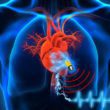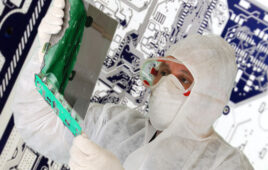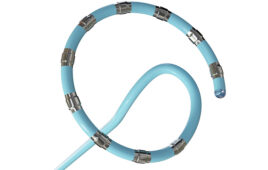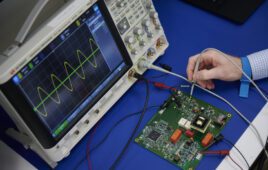
A vagus nerve implant with 2 electrodes – one to apply desired stimulation going down into the body, the other to block unwanted stimulation going up to the brain. [Image from Georgia Tech/Rob Felt]
Researchers implanted a pacemaker-like device into rats and showed that it could electrically stimulate the vagus nerve while simultaneously preventing unwanted nerve activity. By adding inhibiting signals, Georgia Tech researchers could help increase the clinical efficacy and therapeutic benefits of treatments that already exist.
“We use an electrode with a kilohertz frequency that blocks unwanted nerve conduction in addition to the electrode that stimulates nerve activity,” said Robert Butera, electrical engineering professor and principal investigator, in a press release.
“We’ve arranged the 2 near each other, so the blocking electrode forces the stimulation from the stimulating electrode to only go in one direction.”
If they add the technology to existing clinical devices, the researchers suggest they could implement this therapy quickly. Testing in rats has given promising results – and that’s without cutting part of the vagus nerve to optimize the treatment.
“The original studies in animals on the anti-inflammatory benefits of vagus nerve stimulation resorted to nerve transections to achieve directional stimulation as well as boost effectiveness of nerve stimulation,” said lead researcher Yogi Patel, a bioengineering graduate student. “But cutting the vagus is not clinically viable, due to the multitude of vital bodily functions it monitors and regulates. Our approach provides the same therapeutic benefit, but is also immediately reversible, controllable, and clinically feasible.”
The vagus nerve is responsible for feeling limited sensations like pain and heat in some internal organs. It is located outside of the spinal column and runs in 2 parts down the front of the neck.
“The vagus nerve conveys an incredible amount of information related to the state and function of the visceral organs – your digestive tract, your heart, your lungs, information about the nutrients you eat – anything required for homeostasis (physiological balance),” Patel said.
If the immune system is hyperactive, it attacks uninfected tissues in addition to pathogens, eventually causing rheumatoid arthritis, irritable bowel syndrome and Crohn’s disease. Traditional drug-based therapies don’t help.
Usually electrical stimulation can help, but it tends to excite the part of the nervous system that causes a response from the immune system.
“Every circuit has a path coming from the brain and one going to the brain, and when you stimulate electrically, you usually have no control over which one you get. You usually get both,” said Patel.
The solution the Georgia Tech researchers came up with was to stimulate downward while blocking upward vagus nerve activity. Inflammation significantly decreased, according to blood tests of animals receiving the treatment.
The research was funded by the National Institutes of Health and Ian’s Friends Foundation. It was published online in the journal Scientific Reports.
[Want to stay more on top of MDO content? Subscribe to our weekly e-newsletter.]






